The Science of Religion and Spiritualism
- Mr_Solid.Liquid.Gas
- Aug 12
- 16 min read
From the Big Bang and the creationism debate to moon phase rituals, the aurora borealis and crystal healing science—and even today’s astrology trends powered by AI horoscopes—this guide explores where science and spirituality meet.
We unpack cosmology and faith without the “science vs religion” shouting match, explaining lunar cycle science (chronobiology, tides), the real space weather behind the northern lights (solar wind, magnetosphere), and what quartz vibrations do—and don’t—mean in alternative therapy.
Finally, we examine why zodiac signs still dominate short‑form video platforms and how TikTok astrology and AI horoscope apps personalize meaning.
Whether your interest is cosmology and faith, Arctic spirituality and northern lights meaning, or the evidence behind crystal healing and pseudoscience claims, you’ll find clear, respectful explanations and practical images to illustrate key ideas.

Big Bang vs Creationism:
Can Physics and Faith Co-Exist in 2025?

In 2025 the creationism debate shows no sign of fading. A 2024 Gallup survey still finds 37 % of U.S. adults identifying as “young-earth” creationists, 34 % embracing God-guided evolution, and 24 % backing evolution with no divine roleGallup.com.
Meanwhile, the Institute for Creation Research’s summer schedule includes a “100 Years of Monkey Business” conference marking the Scopes trial centennialicr.org.
On the other side of the ledger, the James Webb Space Telescope (JWST) continues to pour out exquisitely detailed images that enrich the Big Bang model, even as some early findings spark lively controversy among cosmologists Live Science.
Clearly, science vs religion is still a live headline—but the story is more nuanced than a simple zero-sum bout.

What Modern Cosmology Actually Says
At its core, the Big Bang theory explains three empirical pillars of 20th- and 21st-century astronomy: the expansion of space (measured ever since Edwin Hubble’s 1929 paper), the helium and deuterium abundances predicted by Big-Bang nucleosynthesis, and the near-uniform glow of the cosmic microwave background (CMB).
ESA’s Planck satellite mapped that ancient light with micro-kelvin precision, revealing tiny temperature ripples that match the statistical fingerprint of an expanding,
13.8-billion-year-old cosmos European Space Agency.
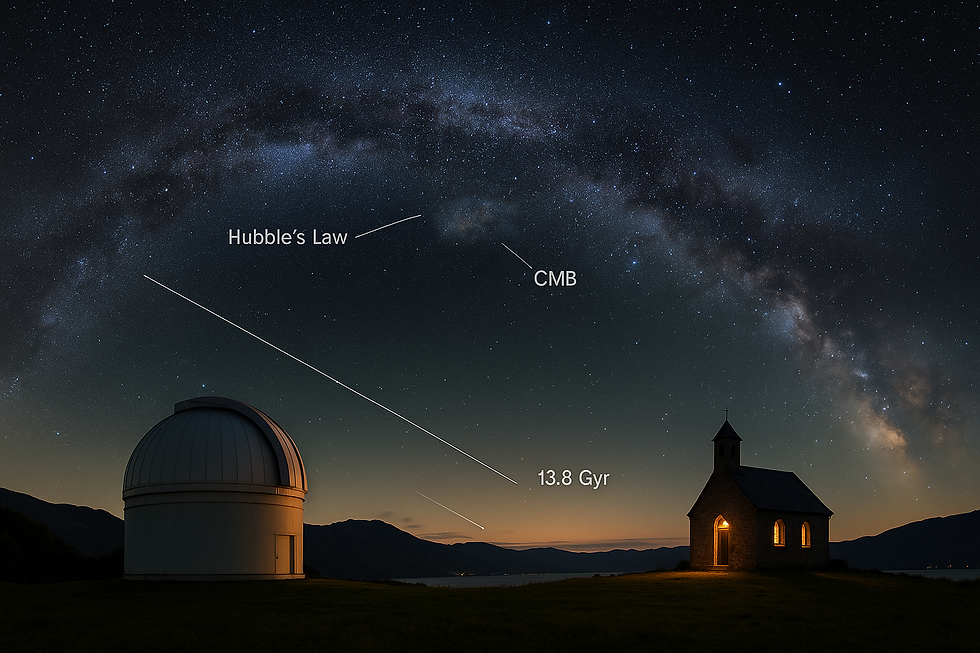
JWST now extends the observable frontier to a mere 350 million years “after” the primordial flash.
Some ultra-bright, unexpectedly mature galaxies have prompted headlines about the Big Bang being “in trouble,” yet follow-up studies show many early objects were initially mis-measured and are less massive than first thought.
NASA’s own re-analysis of several high-redshift galaxies concluded they were “not too big for their britches after all”—still surprising, but well within ΛCDM (Lambda-Cold-Dark-Matter) cosmology’s elastic bounds NASA Science.
Far from collapsing, the mainstream model is being stress-tested and refined.
Why Creationism Persists
If the scientific narrative is so robust, why does creationism retain cultural traction? Part of the answer is existential: cosmology addresses how the universe evolves, but many people ultimately want to know why it exists and who—if anyone—intended it.
Leading creationist writers therefore focus less on arc-seconds and more on purpose, meaning and biblical authority. Articles such as “Distant Galaxies Continue to Challenge the Big Bang” argue that JWST’s early-galaxy tally defies naturalistic formation timelines and instead showcases instantaneous creationicr.org.
Conferences, homeschool curricula and a growing YouTube ecosystem supply a ready-made interpretive community that reinforces this worldview.
The Middle Ground: Cosmology and Faith
Yet the perceived warfare between science and religion is hardly universal. The Vatican Observatory—founded in 1891 and still staffed by Jesuit astronomers—openly studies exoplanets, meteorites and the early universe. Addressing scientists at a 2024 Castel Gandolfo conference, Pope Francis praised their investigation of “cosmological singularities” and reaffirmed that creation and the Big Bang are “two distinct realities” that need not clashpress.vatican.va. Brother Guy Consolmagno, the observatory’s director, cheerfully notes that even atheists must experience an “Oh-my-God” moment when they glimpse JWST’s deep-field mosaics The New Yorker.
Among Protestant scholars, the “theistic evolution” or “evolutionary creation” camp frames the Big Bang as God’s chosen mechanism—akin to gravity shaping planets or plate tectonics sculpting continents.
Their hermeneutic treats Genesis 1 as an ancient liturgy rich in theological, not geological, symbolism. This approach does not erase miracles; it simply locates them in what 19th-century theologian Charles Kingsley called “a universe so full of God that it obeys God at every moment.”
A Constructive Dialogue for 2025

Can physics and faith co-exist? Practically, they already do. The JWST proposal teams include devout Muslims, Hindus, Christians and secular humanists.
Creationist ministries employ Ph.D. physicists who publish peer-reviewed papers on thermodynamics. The real challenge is epistemic humility: scientists must acknowledge the provisional nature of models, while theologians must recognize that sacred texts sit within specific literary genres and ancient cosmologies.
Educationally, framing the Big Bang and creation accounts as complementary lenses can lower cultural temperature. High-school teachers in interfaith classrooms have found success by starting with shared awe: whether one calls it Creation or cosmic dawn, the night sky elicits wonder.
From that common ground, students can explore evidence—CMB maps, galaxy redshifts, primordial element ratios—without dismissing personal beliefs about meaning and purpose.
Conclusion
In 2025 the Big Bang–creationism debate remains headline-worthy, but the battlefield metaphor obscures more than it reveals. Cosmology continues to refine the how of the universe’s 13.8-billion-year story, while faith traditions wrestle with the why. Between them lie countless individuals—scientists who pray, believers who program JWST algorithms—demonstrating that cosmology and faith need not be foes. Rather than asking which side will “win,” a richer question emerges:
How can the dialogue between Big Bang science and creationist conviction deepen our collective sense of wonder?
Moon Phase Rituals Explained by Chronobiology & Tidal Forces
(moon phase rituals · chronobiology · lunar cycle science · spiritual practices)

1. Why the Moon Still Pulls Our Imagination
Scroll through #FullMoonRitual or #LunarManifestation on TikTok and you’ll find millions of clips—from cinnamon-blowing prosperity spells to carefully timed tarot spreads.
The Cambridge Dictionary even chose “manifest” as its 2024 Word of the Year, noting a surge in posts linking positive visualisation to lunar phases.
The Guardian Cultural analysts call it part of “WitchTok,” a broader revival of folk magic that offers comfort when the world feels irrational.
The Guardian Far from fringe, these spiritual practices are now stitched into mainstream self-care routines.
But what, if anything, does modern science say about the Moon’s influence?
2. Lunar Cycle 101: Light, Gravity and Timing
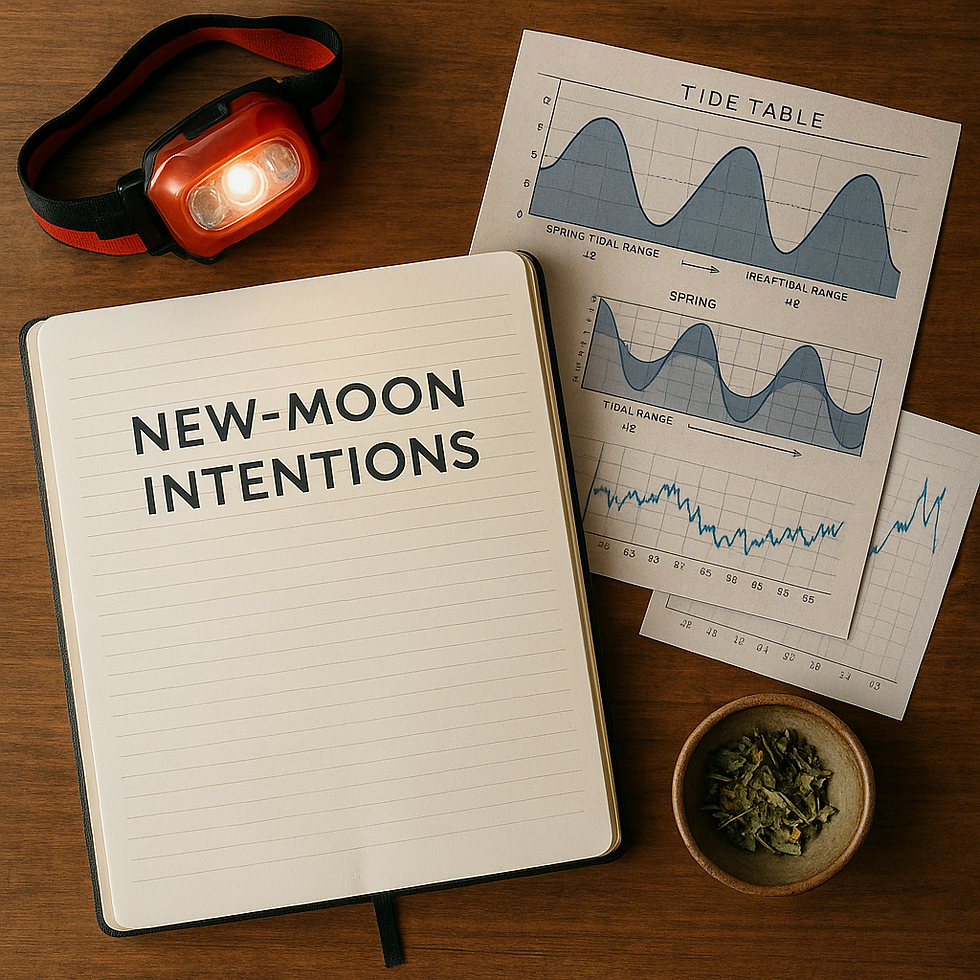
The Moon completes a 29.5-day synodic cycle divided into eight familiar phases, each differing in apparent brightness and relative position to Earth and Sun.
NASA explains that the same gravitational tug that locks one lunar face toward us also raises twin tidal bulges in our oceans, producing predictable spring (full/new) and neap
(quarter-phase) tides. NASA Science

These mechanical facts underpin many coastal fishing calendars—and by extension some agricultural and spiritual calendars that still “plant by the Moon.”
3. Human Chronobiology: Do We Feel the Phases?
Clinical chronobiologists have hunted for a circalunar rhythm in people for decades.
A tightly controlled Swiss sleep-lab study published in Current Biology found that around the full Moon participants took five minutes longer to fall asleep, lost 20 minutes of total sleep, and experienced a 30 % drop in deep (delta-wave) sleep. PubMed
A 2021 field study comparing three electricity-free Argentinian villages with urban Seattle students reported the shortest sleep three-to-five nights before a full Moon, regardless of artificial lighting. UW Homepage
Meta-analyses remain mixed, but a recent review for Sleep Foundation summarises converging evidence that lunar cycles can modestly delay bedtime in many people. Sleep FoundationSELF
4. Possible Mechanisms—And Their Limits

Moonlight: Even at its brightest, moonlight is only ~7 % as intense as daylight. Yet our melatonin-driven circadian clocks are exquisitely light-sensitive and may have evolved to exploit dusk-time brightness for nocturnal foraging. SELF
Geomagnetism: During full Moon the lunar surface passes through Earth’s magnetotail, becoming negatively charged and subtly tweaking geomagnetic conditions—shifts known to influence cardiovascular and hormonal variables in some studies. Sleep Foundation
Gravity: Popular lore invokes “we are 70 % water,” but the lunar tidal force on a human body is less than one-millionth the width of an atom—vanishingly small. Sleep Foundation
Taken together, chronobiologists argue that light, and perhaps magnetism, are more plausible drivers than gravity for the subtle sleep changes seen near full Moon.
5. Lunar Clocks Beyond Humans
In the ocean, the Moon’s influence is unambiguous.
Mass coral-spawning on Australia’s Great Barrier Reef, the synchronized emergence of Palolo worms in Samoa, and the breeding runs of California grunion fish are all locked to spring-tide evenings following a full or new Moon.
Genetic work now shows marine species possess specialised “lunar timers” that integrate nocturnal light and tidal cues. PMC
These findings demonstrate that circalunar rhythms are not folklore but a genuine branch of chronobiology—though their molecular gears remain a hot research topic.
6. Rituals as Embodied Ecology
Given this backdrop, it’s unsurprising that human cultures long ago wove spiritual practices into lunar landmarks:
Agriculture: Biodynamic farmers still sow leafy crops on waxing Moons, echoing ancient Babylonian and Chinese almanacs.
Religious calendars: The Islamic Hijri calendar is purely lunar, and Easter is calculated from the first full Moon after the vernal equinox.
Modern self-care: Full-Moon journaling, new-Moon intention-setting and group sound-baths offer structured reflection points roughly every fortnight—aligning personal goal-setting with a visible sky clock.
Psychologists note that such rituals, whether scientifically “effective” or not, can reduce anxiety by supplying rhythm, community and a sense of agency—a kind of placebo powered by celestial theatre.
7. Bridging Science & Spirituality in 2025
So, do moon phase rituals “work”?
From a strict mechanistic angle, the Moon cannot cleanse crystals or guarantee lottery wins.
Yet chronobiology shows that lunar cycle science modestly modulates sleep, and tidal forces undeniably choreograph marine life.
Recognising these facts does not invalidate spiritual practices; rather, it reframes them as culturally meaningful responses to subtle environmental rhythms.
For educators and ritual-makers alike, the most fruitful stance is integration, not confrontation:
Use observable data—tide charts, sleep-tracker readouts—to teach how natural cycles operate.
Encourage mindful rituals as opportunities to sync personal intentions with the broader cadence of Earth–Moon dynamics.
8. Take-Home Moonlight
Whether you charge quartz under a waxing gibbous or simply marvel at spring-tide surf, you are participating in a dialogue as old as humanity.
Modern chronobiology continues to peel back the layers of that conversation, while spiritual practices keep its poetry alive.
In 2025, the choice needn’t be science versus spirituality—it can be science and spirituality, each illuminating a different facet of our enduring lunar bond.
Northern Lights Spirituality: The Real Space-Weather Science Behind the Aurora Borealis
(aurora borealis · space weather · northern lights meaning · Arctic spirituality)

1. A Celestial Canvas Shared by Science and Spirit
Few natural spectacles stir the soul like the aurora borealis.
For Arctic communities the lights have long been portals to the sacred—omens, ancestors, even playful spirits in Inuit tales.
For physicists they are the visible footprint of space weather, the solar wind slamming into Earth’s magnetic shield.
The beauty of 2025 is that both stories can be told at once, enriching rather than erasing each other.
2. How Space Weather Paints the Sky
The Sun releases a continual stream of charged particles; when sunspot activity peaks during a solar maximum those particles surge.
NASA and NOAA predict Solar Cycle 25 will crest around July 2025, meaning stronger, more frequent auroras for the next two winters. Aurora Zonenorthernlightscanada.com
When this solar wind reaches Earth, it is funnelled by the magnetosphere toward polar regions.
There, particles collide with atmospheric oxygen and nitrogen, exciting them to emit green, crimson or violet light—a planetary neon sign stretching 100–400 km above our heads. NASA Jet Propulsion LaboratoryNOAA Space Weather Prediction Center
The same physics that inspires night-sky pilgrims also poses risks.
Geomagnetic storms can distort GPS, force airlines onto longer equatorial routes, and even trip power grids—the 13 March 1989 Quebec blackout is the textbook cautionary tale. Spaceweather.comNOAAWIRED
Modern utilities now harden transformers and follow NOAA’s G-scale alerts, yet experts warn that a Carrington-level storm could still cost trillions. The New YorkerThe Times

3. Northern Lights Meaning in Arctic Traditions
Indigenous narratives frame the aurora as something to respect, not merely photograph.
Culture | Traditional understanding | Guidance |
Sámi (northern Scandinavia) | Souls of the departed; lights must not be whistled at or mocked, lest they swoop down. Hurtigruten | Keep silent, wear red to show reverence. |
Inuit (Alaska, Canada, Greenland) | Spirits playing ball with a walrus or human skull; some groups saw past relatives dancing. Natural Habitat Adventures | Avoid waving or calling out, which could attract their attention. |
Finnish “Revontulet” | A magic fox sweeping sparks across the snow with its tail. Aurora Zone | Storytellers use it to teach humility before nature. |
These teachings foster a relationship of caution and gratitude—qualities space-weather scientists increasingly echo when they discuss grid resilience and satellite safety.
4. From Myth to Mindfulness: Today’s Aurora Pilgrims
Affordable polar flights and all-sky aurora apps have turned Lapland, Iceland and Yukon into bucket-list destinations.
Some travellers seek Arctic spirituality: yoga under dancing curtains, Sámi-led drum ceremonies, or silent-sky meditation retreats where guests “ground” themselves in cosmic rhythms. JoinMyTripmikaelasol.com
Psychologists link such awe-inducing experiences to lower stress and greater prosocial behaviour; spiritual guides simply call it reconnection.
Either way, science and ritual are again entwined: geomagnetic forecasts pick the night, ancient stories give it meaning.
5. Seeing the Lights—Respectfully and Responsibly
Follow the forecast. NOAA’s 30-minute aurora model and the K-index alert you to incoming geomagnetic shocks; a Kp ≥ 4 often signals visible auroras at 55° N.
Minimise light pollution. Rural coastlines or upland tundra offer darker horizons and mirror-like reflections on snow or sea ice.
Listen to local knowledge. Sámi reindeer herders or Inuit guides may share protocols—no loud music, no drones near sacred sites—that protect both wildlife and cultural heritage.
Acknowledge the hazards. Solar storms disrupt communications; carry analogue maps, and if you rely on HF radio or GPS know their space-weather limitations.
Practise mindful awe. Whether you whisper a prayer, run a long-exposure shot, or simply stare, allow the moment to expand rather than conquer it.

6. Toward an Integrated Aurora Ethic
The aurora borealis is neither mere spectacle nor solely a lab experiment; it is a living dialogue between Sun, Earth and human imagination.
Modern satellites—Parker Solar Probe, ESA’s Cluster fleet—decode plasma flows so utilities can safeguard power grids.
Meanwhile, storytellers keep alive the sense that shimmering skies carry messages beyond data.
Holding both truths cultivates what scholars call epistemic humility: the recognition that empirical knowledge and spiritual wisdom illuminate different facets of one phenomenon.
In that spirit, 2025’s solar maximum is not just a physics milestone; it is an invitation to stand beneath the northern lights, feel their charged silence, and ponder our place in a cosmos that is at once measurable and mysterious.
May your next aurora chase deliver not only perfect geomagnetic indices but also the quiet thrill of knowing you are woven into the same solar-terrestrial tapestry that inspired ancestors, guides physicists, and still lights up the human heart.

Crystal Healing Under the Microscope:
Do Quartz Vibrations Matter?
(crystal healing science · quartz vibrations · pseudoscience · alternative therapy)
1. A Billion-Dollar Bedside Table
From Instagram “crystal grids” to rose-quartz facial rollers, semiprecious stones have migrated from New Age shops into mainstream wellness.
Market researchers lump crystal healing into the broader “body-mind-energy” segment, valued at US $78.6 billion in 2023 and projected to quintuple by 2030 Grand View Research.
Reports that focus only on loose crystals and tumbled gemstones still estimate a US $31.8 billion slice by 2023, rising to US $44 billion by 2030 Arabian Business.
Popularity, however, is not proof—so what happens when the lab light replaces the candlelight?
2. Quartz 101: Real Vibrations, Specific Uses
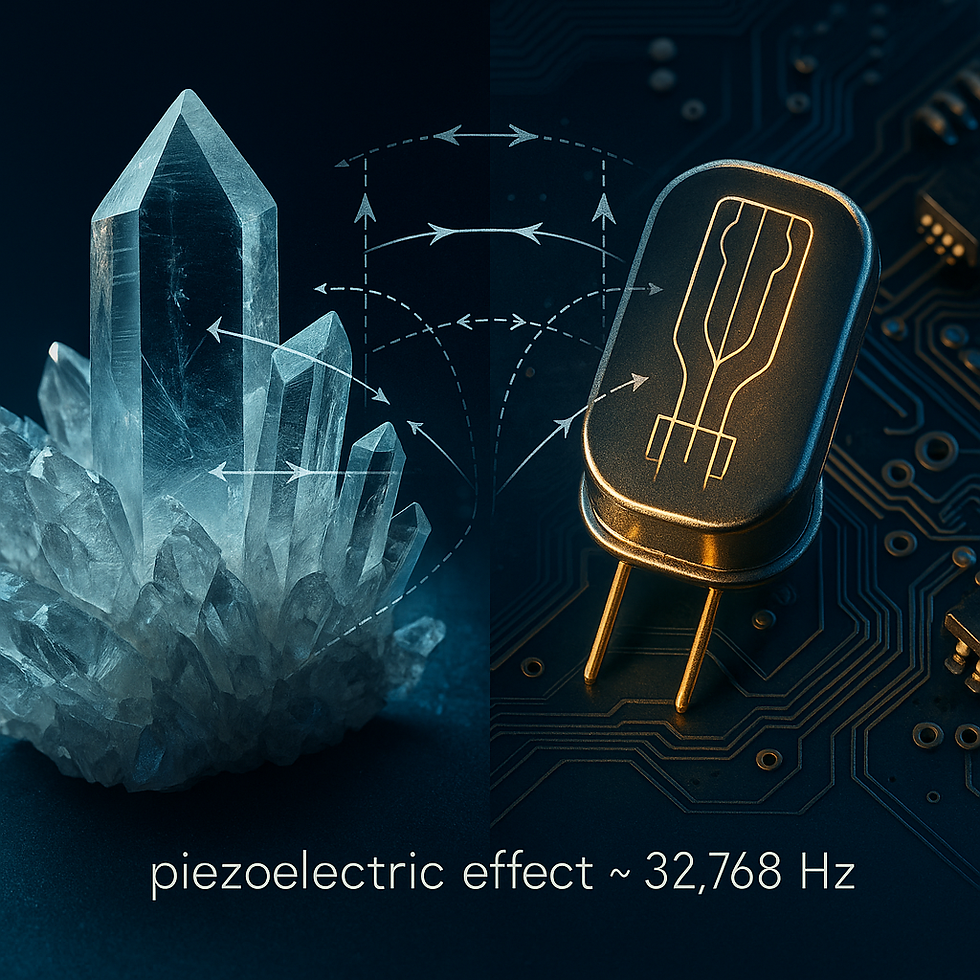
Quartz is prized in electronics because of the piezoelectric effect: squeeze the crystal and an electric charge appears; apply a voltage and it vibrates at a stable frequency.
That is why nearly every wrist-watch oscillator hums at 32 768 Hz, a power-of-two that divides neatly down to one pulse per second NISTNIST.
Engineers love this predictability, but the key question for health claims is whether those microscopic lattice oscillations can meaningfully interact with cells meters away in the human body.
Physics offers a blunt answer: in air, the energy dissipates within fractions of a millimetre, and our tissues are thousands of times too thick to resonate at those radio-like frequencies.
3. What Healers Say Happens
Practitioners counter that crystals act not through conventional force but by tuning “subtle energies.”
A widely-circulated primer describes stones as conduits that “encourage the flow of positive energy into the body and push out negative, disease-causing energy.” ulc.org
Quartz, with its orderly silicon-oxygen lattice, is thought to amplify intentions, cleanse auras, or align chakras.
These claims draw on centuries-old lapidary lore—and for many users the ritual itself, whether moon-charging a geode or placing points around a yoga mat, is as important as any measurable output.
4. When Science Tests the Claims

The best-known double-blind study was run by psychologist Christopher French at Goldsmiths, University of London.
Volunteers meditated with either genuine quartz or identical-looking glass; believers in the paranormal reported tingling, warmth and “energy flows” regardless of the stone’s authenticity, leading researchers to conclude that crystals offer no effect beyond placebo
Twenty-first-century work has reinforced that verdict.
A small 2024 randomized controlled trial of chronic-pain patients found no statistically significant difference between amethyst-and-quartz therapy and sham glass replicas, though both groups improved slightly—again pointing to expectation effects dev.nobleblocks.com.
Systematic reviews of complementary medicine databases have yet to locate any large-scale trial showing crystals outperforming inert placebos on objective biomarkers Wikipedia.
5. The Placebo—But Far from “Just”
Dismissing the placebo as trivial misses its documented power.
A 2024 Michigan State study showed that even open-label placebos—pills honestly labelled “placebo”—reduced stress and depression over two weeks psychology.msu.edu.
Neuro-imaging research finds placebos can dampen amygdala activity and raise social trust, activating endogenous opioid and oxytocin pathways PNAS.
Crystals, colourful and tactile, may super-charge these expectancy loops: they are props that make intention feel concrete.
From a psychobiological standpoint, that can still translate into lower perceived pain or calmer heart-rate variability, even if no quartz photon penetrates deep tissue.
6. Integrative Medicine, Not Either–Or
Ethical clinicians therefore treat crystal healing as an adjunctive ritual—a way to bolster mindfulness or adherence—rather than as a replacement for proven therapies.
Many hospitals now designate “wellness rooms” where Reiki, meditation and yes, crystal bowls, are offered alongside chemotherapy or physiotherapy.
The World Health Organization’s traditional-medicine strategy emphasises informed consent: patients should understand where evidence ends and belief begins.
That clarity helps avoid the tragic delays in diagnosis that critics of alternative therapy rightly fear.
7. Hidden Costs: Mining, Labour and the Planet

A clear quartz cluster may look pure, but its journey can be anything but.
Investigations in Madagascar and Myanmar describe dangerous, poorly regulated mines and child labour feeding the wellness boom The Guardian.
Environmental journalists warn that crystals are a non-renewable resource; stripping rain-forest hillsides for rose quartz can leave rivers silt-choked and communities displaced.
Ethical suppliers do exist—some even offer blockchain tracking—but the industry is largely self-policed, leaving consumers to weigh the spiritual gloss against tangible human and ecological footprints.
8. So, Do Quartz Vibrations “Matter”?
From a strict biophysical lens, the answer remains no: the measurable electric oscillations that make quartz reliable in clocks are far too faint and high-frequency to retune human cells.
Yet the meaning assigned to those crystals can matter very much—through placebo pathways, ritual structure, and the simple act of pausing to breathe while holding a cool, luminous stone.
For science educators, the most constructive stance in 2025 is curiosity without credulity:
Explain the real physics of piezoelectricity.
Acknowledge the psychological value of ritual and symbolism.
Encourage ethical sourcing and medical transparency.
Approached this way, crystal healing becomes neither a threat to evidence-based medicine nor a target for ridicule.
It is a cultural practice whose perceived benefits arise from mind–body interactions we are only beginning to map.
In that sense, the quartz in your hand vibrates—if not electromagnetically through your bloodstream, then metaphorically through your expectations, memories and hopes.

Recognising the difference empowers both healer and sceptic to share the same crystal-clear goal: genuine well-being, grounded in both reason and respect.
Zodiac Signs in the Age of AI:
Why Astrology Still Trends on TikTok
(astrology trends · zodiac signs · TikTok astrology · AI horoscope)
1 · A 4.5-Million-Video Hashtag—and Growing
Open TikTok and type “astrology.” You’ll scroll past more than 4.5 million clips—retrograde rants, “Mercury-in-Leo” memes and twelve-part skits that personify each sign as a college roommate.
The platform’s For You algorithm thrives on recognizable characters, and the zodiac offers an off-the-shelf cast.
Thirty seconds is plenty of time to tease a Virgo about tomorrow’s lunar square or to roast an Aries–Gemini couple.
Every like and duet trains the recommender engine, turning astrology itself into a self-reinforcing feedback loop of personalized content.
2 · Enter the Astro-Bots: AI Horoscopes on Demand
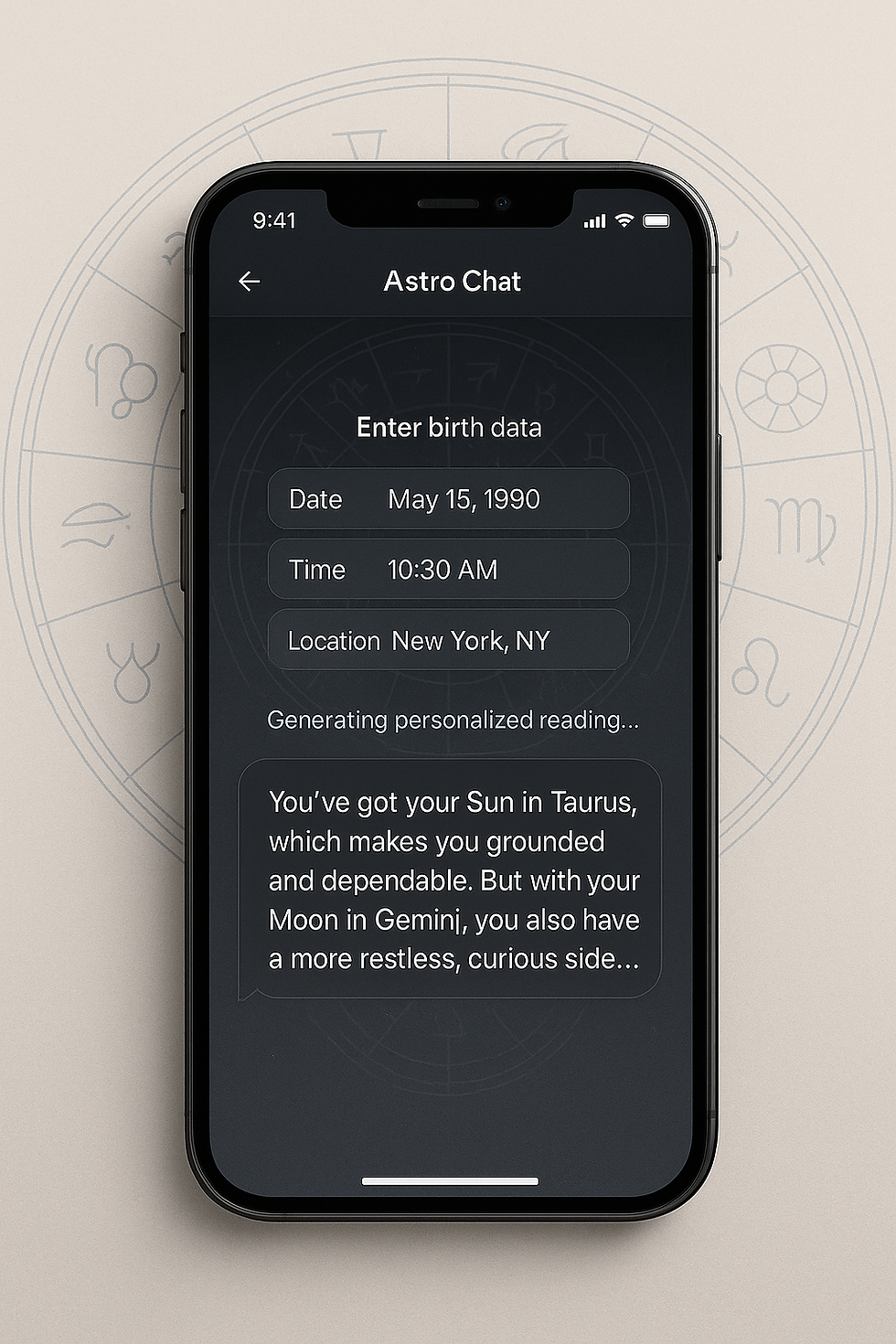
The newest twist is the AI horoscope.
Apps such as Co-Star, Chani and Nebula now bolt large-language models onto ephemeris databases, chatting about synastry, retrogrades and transit forecasts in natural language.
On TikTok, the tag #AstroGPT shows creators screen-recording conversations with chatbots that recommend career moves for Capricorns or predict how a Scorpio full moon might intensify emotions.
Hyper-personalization is the hook: a newspaper column offers twelve generic blurbs; an LLM can calculate every planet in your chart, cross-reference it with your last month of texts and deliver advice that feels uncannily specific—share-worthy, even if the cosmology is unproven.
3 · The Psychology of Cosmic Comfort
Surveys taken in early 2024 found that roughly 70 percent of U.S. adults consider astrology helpful; among millennials the figure climbs above 80 percent.
Asked why, respondents point to “comfort during uncertain times” and “language for self-reflection.”
Creators echo that sentiment: one viral clip calls learning your Leo rising “a new KPI for self-optimization,” blending corporate jargon with cosmic determinism.
In an economy marked by gig work, student-loan anxiety and algorithmic performance reviews, astrology offers the soothing promise that a pattern exists—and that you can read it.
4 · Roll-Call of the Signs—Classic Archetypes Meet TikTok Personas

Below is an updated look at each zodiac sign, pairing its traditional archetype—rooted in centuries of astrological lore—with the role it tends to play in 2025’s TikTok astrology trends:
Sign & Dates | Ancient Archetype | 2025 TikTok Persona Snapshot |
Aries(21 Mar–19 Apr) | The Warrior / Pioneer—initiative, courage | First-mover energy: “Just do it” challenges, hot-take duets, spontaneous road-trip vlogs |
Taurus(20 Apr–20 May) | The Builder / Sensualist—stability, pleasure | Soft-life curator: matcha recipes, luxe-on-a-budget hauls, bedroom-makeover ASMR |
Gemini(21 May–20 Jun) | The Messenger / Trickster—curiosity, duality | Hot-take factory: rapid-fire debate stitches, multitasking study streams, prank-call humor |
Cancer(21 Jun–22 Jul) | The Nurturer / Protector—empathy, memory | Digital mom-friend: comfort-food tutorials, mental-health check-ins, cozy-vlog ambience |
Leo(23 Jul–22 Aug) | The Performer / Sovereign—creativity, pride | Main-character glow: GRWM reels, mirror affirmations, dramatic “day in my life” shorts |
Virgo(23 Aug–22 Sep) | The Analyst / Healer—precision, service | Spreadsheet sorcerer: bullet-journal hacks, productivity pomodoro loops, data-driven self-care |
Libra(23 Sep–22 Oct) | The Diplomat / Artist—harmony, aesthetics | Aesthetic referee: outfit-rating stitches, nail-art polls, conflict-mediator skits |
Scorpio(23 Oct–21 Nov) | The Alchemist / Detective—depth, transformation | Mystery-Tok maven: late-night tarot flips, true-crime commentary, shadow-work prompts |
Sagittarius(22 Nov–21 Dec) | The Explorer / Philosopher—adventure, truth | Nomad coach: airport vlogs, language-learning hacks, big-picture hot takes on culture |
Capricorn(22 Dec–19 Jan) | The Strategist / Authority—discipline, legacy | Quiet-luxury strategist: career-advice reels, side-hustle breakdowns, stoic quotes |
Aquarius(20 Jan–18 Feb) | The Visionary / Rebel—innovation, reform | Techno-utopian: AI-tool tutorials, climate-protest coverage, indie-music recommendations |
Pisces(19 Feb–20 Mar) | The Mystic / Dreamer—compassion, imagination | Dream-pop empath: ambient playlists, poetry recitations, surreal editing filters |
By weaving these archetypes into short-form storytelling, creators tap deep mythic themes and keep the content instantly relatable.
Comments sections fill with “So true, I’m such a Taurus” replies—community micro-moments that boost engagement and push the video onto more screens.
5 · A Booming Cosmic Economy

Attention converts to revenue.
Market analysts expect the global astrology-app sector to triple from about $3 billion in 2024 to nearly $9 billion by 2030, propelled by premium AI-horoscope subscriptions, compatibility dossiers and push-notification transit alerts.
TikTok’s own monetization tools pour gasoline on the trend: during live “astro-tarot” streams, viewers send virtual roses or galaxies to bump their question in the queue—micro-transactions that add up fast.
6 · Reality Check and Ethical Guardrails
Astrology remains invalidated by double-blind scientific tests; personality-sign correlations stick close to chance.
Professional astronomers worry about blurring the line between science and mysticism, while therapists warn against fatalism (“My chart made me do it”).
Ethical astrologers respond with disclaimers—“guidance, not diagnosis”—and partnerships that route distressed users toward licensed counsellors.
Critical thinking and cosmic storytelling, they argue, can co-exist under informed consent.
7 · Looking Ahead: Cosmic Code-Switching
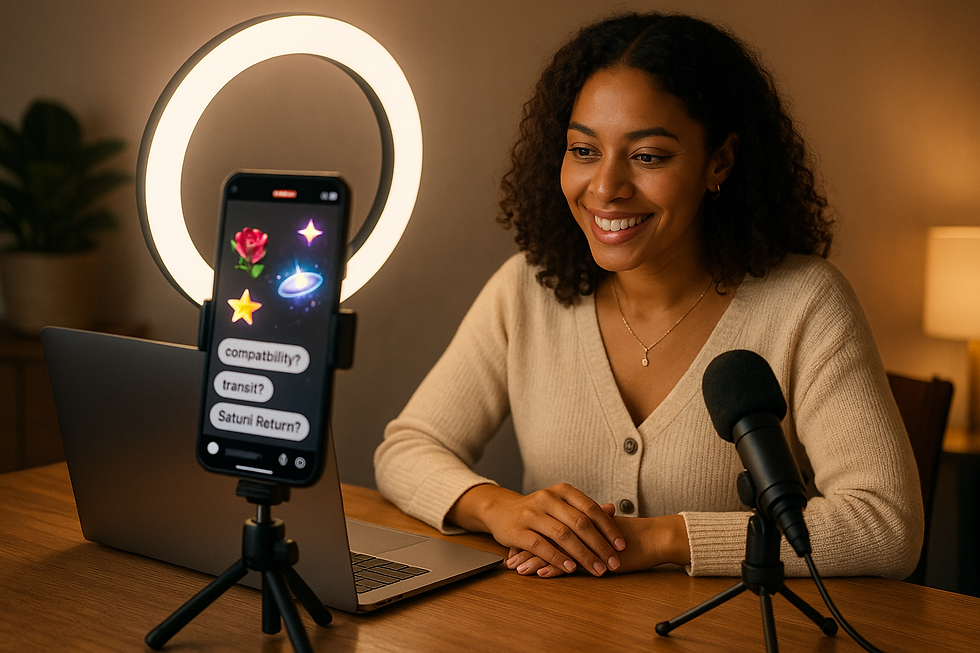
Expect mixed-media horoscopes: voice-activated natal briefings in smart cars, AR sky maps showing tonight’s Sagittarius moon overlay, even blockchain-verified “astro IDs” in dating profiles.
Whether these tools deepen self-knowledge or simply gamify existential dread will hinge on design ethics and user literacy.
For now, one fact is clear: astrology’s digital renaissance is less an escape from technology than a way to weave mythic archetypes into algorithmic life.
TikTok decides the next clip you see, but a zodiac meme still gives language for heartbreak, hustle or hope.
If the stars are our mirror, AI is just polishing the glass—and millions are still eager to look.

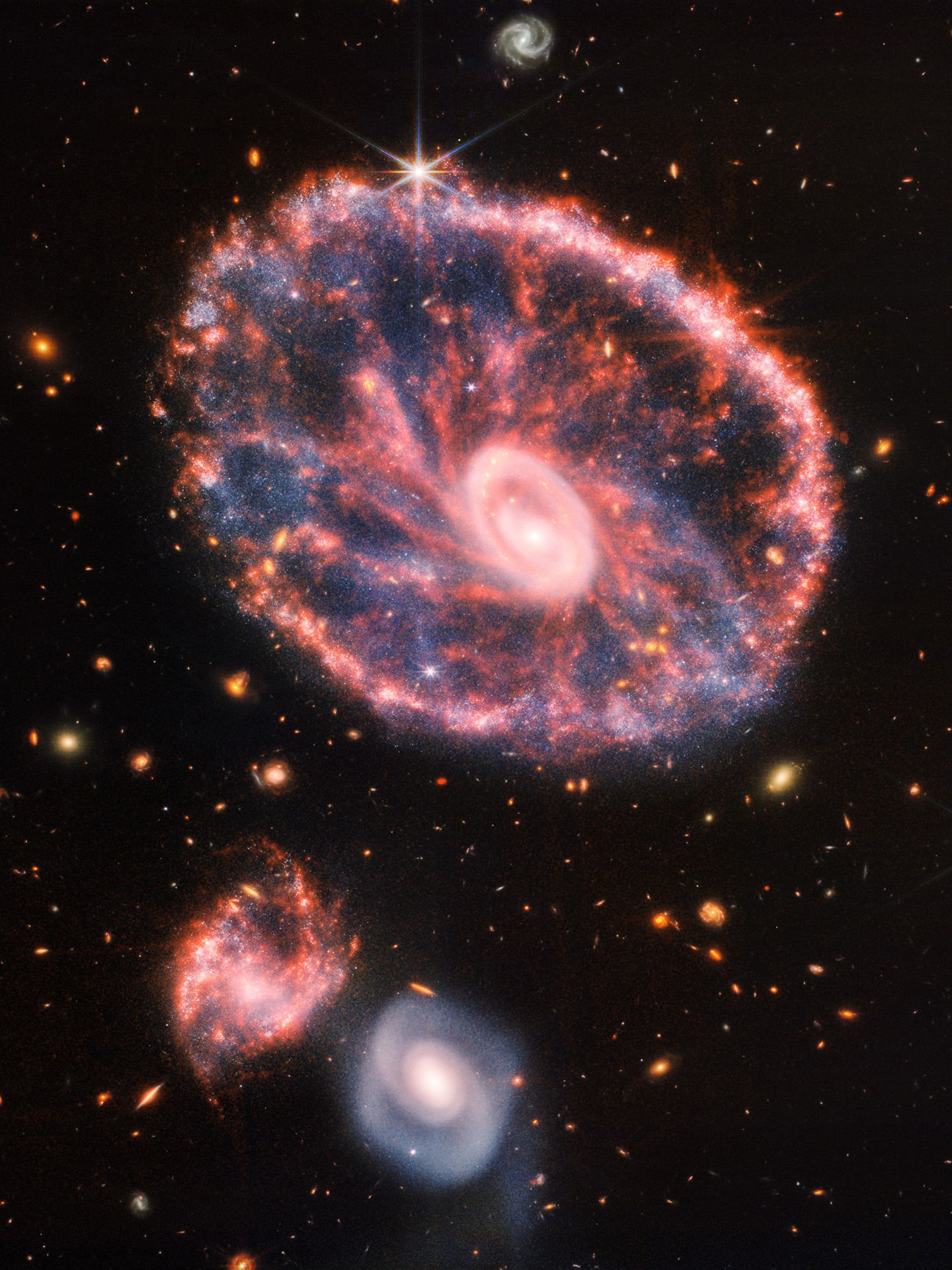






















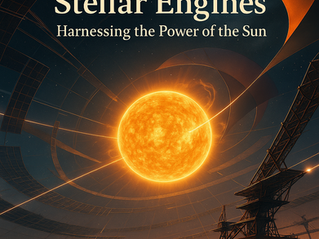




















































































Comments